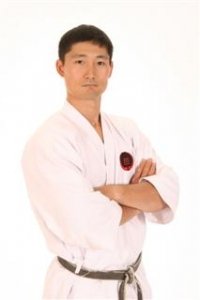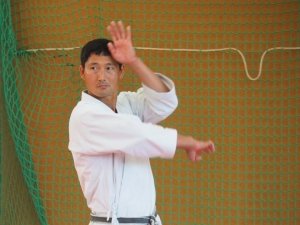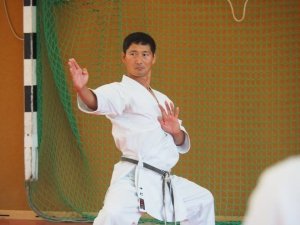Sensei Tetsuji Nakamura is world chief instructor of the International Okinawan Goju-ryu Karate-do Federation (IOGKF), the largest Okinawan traditional Karate organisation in the world. Sensei Nakamura is successor of this role from Master Higaonna, the original founder of the federation, and now acts as the head of over 75,000 members in 60 plus countries…
Firstly, how is Higaonna Sensei doing now?
Higaonna Sensei is doing very good. He is recovering very well now. Every day now he is walking outside to help in his rehabilitation and is getting stronger little by little. When he is feeling very good he comes to the Dojo and give lectures and provides technical training. He is even teaching a little bit, so he is getting much better now and I can see that he is improving a lot.
You have been IOGKF World Chief Instructor for three years now. How is it all going and how is IOGKF evolving, because it’s a big job?
(Laughs). Yes it is! It’s a big job, but things are going well. I have lots of support from all the senior instructors and country chief instructors from around the world. It’s a big task with a big responsibility, but I just take it each day at a time. Lots of good things are happening in IOGKF and we are still very lucky that Higaonna Sensei is still around and I can ask his advice and still grow as the world chief instructor. The last three years have been really busy, but it’s a good busy and I’m happy.
The 2016 IOGKF World Budosai is on next year. What is so special about this World Budosai compared to previous World Budosai?
Well, Higaonna Sensei is really focusing on bringing traditional Karate forward to be recognised by UNESCO as a special culture heritage. Higaonna Sensei is working hard with other traditional Karate organisations and also the Okinawan government as well, and he wants us to demonstrate to UNESCO how strong traditional Karate is. Higaonna Sensei wants us to show how many people are attracted by and enjoy traditional Karate. Higaonna Sensei wants everyone to come to Okinawa to train together and make a great demonstration to achieve this. He is hoping to show the government also how Karate has come from such a small island to now be enjoyed by people all over the world. We also want to run a demonstration to show that Karate is not just an Okinawan thing anymore and that Karate has grown another level to become world culture.
This is Higaonna Sensei’s main focus for the World Budosai and that is definitely different from past Budosai events.
For people who haven’t been to Okinawan before, what does Okinawan have to offer and why should they go?
You know I always tell my students that Okinawa is ultimate Karate destination. Anyone who practices traditional Karate should visit Okinawa at least once in their lifetime. You can really feel Karate when you are there. Karate’s main teaching and most important teaching is respect and when you go to Okinawa you can feel this. Karate is such a practical and effective self defence system, but it works together with such a gentle manner and respect. You can really feel this when you arrive in Okinawa. The people of Okinawa are such a respectful people and are so welcoming.
And when you get there, there are lots of historical places you can see. From Shuri Castle, beautiful gardens and small temples around the place. There is also plenty of beautiful nature on offer and if you travel to the North of the island you will see one of the best aquariums in the world.
So of course there is lots about Karate you can see, but also as a tourist there is plenty for you to see and do there and you can enjoy it a lot.
You are doing a lot of research into Higaonna Sensei’s life story at the moment. What is the purpose and importance of doing this?
I’ve been interested in looking further into this for a number of years and had lots of encouragement from many different people. Higaonna Sensei is such a humble individual and he doesn’t talk about himself and what he has done and achieved. He is always talking about his Sensei and his Sensei’s teachers, he never actually talks about himself. So many people have said to me, because I am so close to Higaonna Sensei, I should ask him questions about his life and also of all the students of Higaonna Sensei.
We don’t know much about Higaonna Sensei’s early life and I want people to know how hard he trained, what kind of relationship he had with his teacher and what made him who he is now. I think it is really important for not only me, but all the Karate-ka out there to know who Higaonna Sensei really is as a person. He has had lots of struggles. Higaonna Sensei has had many triumphs, but he has also had many bad and down times too. However through all these experiences, he has now become the best master in the world.
I want everyone to know Higaonna Sensei’s story, I think that it is my responsibility to make sure this happens. I still have lots of questions to ask Higaonna Sensei and this is definitely the biggest project I have ever undertaken. So I am still working hard on it.
Have you learned anything about Higaonna Sensei that you didn’t know before?
Oh yes! Many things. I was so inspired by much of what I have learnt about Higaonna Sensei, especially his strong commitment and spirit. And through it all it has taught me more than ever that Higaonna Sensei is still a human being. He has had struggles and it is strange to see that Higaonna Sensei has a weakness. But it is inspiring to see how he has concurred all of these and grown as a person.
What can you tell us about your own training regime? Is there a certain aspect you focus on more than others?
My own training mainly focuses on the Kata now. When I was younger I loved to fight, so I did lots of sparring training, but now my main training is always on Kata. I still practice Sanchin Kata and all the Hojo undo and traditional weight training. I am always trying hard to move my body in a way that follows the principles of the Goju-ryu style. That’s my challenge at the moment, trying to take all the unnecessary movements out and try to follow purely the internal principles of Goju-ryu. That’s my challenge now with my own training.
You are doing a lot of travel at the moment. How do you balance your own training, family time, running a big Dojo and being chief instructor?
(Laughs). It’s not balance, it’s a struggle! I think this year in particular, I over booked myself. This year I am traveling to 17 different countries and I think maybe that is a little bit too much. So next year I am trying to reduce my travel time.
Like you said, I think balance is the most important part for me. I have a responsibility as the chief instructor, but also I have a responsibility as a father and as a husband, and also to my dojo. It’s a daily struggle for me to keep the right balance. It can be a challenge.
You practiced Judo and another style of Karate prior to starting training in Goju-ryu. Has this experience helped you in any way to reach the level you are at now?
I did lots of competitive Judo when I was in high school. The grappling experience involved with this has really helped me a lot, especially because Goju-ryu has many in close fighting techniques. Just having those basic grappling skills has helped me to become better at the take down movements and also ground fighting, choking and joint locking techniques. It helps make it all flow quite well. I also learned another style of Karate before I met Shuichi Aragaki Sensei.
But I feel that without having had this previous experience, perhaps I wouldn’t have realised how Aragaki Sensei and Goju-ryu Karate as a style were different. If I began my martial arts training directly under Higaonna Sensei or Aragaki Sensei then maybe I wouldn’t have appreciated them as much I do.
So I think those experiences gave me make a stable base for my Karate, but at the same time I was looking for more depth in a style. When I finally saw Aragaki Sensei and Higaonna Sensei, I was changed and it opened doors to a whole new world for me. I believe it is because of this previous experience that I was able to recognise this and fall in love with Goju-ryu.
What advice would you give to Dojo instructors on how to make their Dojo successful but without sacrificing the traditional aspects of Karate?
I really think that balance is important here. When I first started my Dojo I had to ask the same question of myself. How do I have a Dojo in North America as a professional traditional Dojo but at the same time having it make enough money so I can eat? It’s a really challenging thing.
You definitely don’t want to bring in students, just let them play and not teach them any traditional Karate. But at the same time you want to make sure your students are happy and that they stay. You want to make sure they are constantly learning and that they don’t get bored and just quit. It is always a challenge to get the balance right and it is hard to know where to draw the line.
I once asked Sakiyama Roshi, Higaonna Sensei’s zen teacher, as I was really looking for the answer of how to have a commercial Dojo but still teach traditional Karate and also where do I draw the line. His response was very clear. He told me that you need to believe in yourself. From that moment on it all changed for me. You have to believe in your judgement and you need to know where to draw the line in the sand.
I also brought many other business ideas from other Dojo’s, but at the same time I try to keep the quality at a certain level too. Whatever you do, it is how you create the balance and where to draw the line that makes all the difference.
Certain countries have trouble with their attendance numbers in a certain season. For example it might be too hot in summer and people do not want to train. Perhaps winter is too cold and they do not want to go to the Dojo. What do you think is the best way to get around these kinds of issues?
You know this is where you can bring lots of business ideas to your Dojo! Especially for children, they need lots of short term goals. Keep them excited, create small events in the Dojo throughout the year and give them small prizes for their efforts.
I think the small things make a big difference too. How you speak to the children and talk to the parents for example. These kinds of small things add up to make a big difference. And of course, you have to advertise your Dojo from inside and outside. We can learn a lot from other martial arts organisations or other businesses as well to help us overcome these kinds of problems.
In fighting, we use lots of techniques like Mawashi Geri, however when we practice the Kata we don’t use these techniques. Why do you think this is?
Good question. Let’s talk about the Mawashi Geri then. I’m not sure if the Mawashi Geri was really from Karate or not. It could have maybe been added afterwards. I think about many Kata’s and I cannot find Mawashi Geri within them. I’m not an historian either, so I don’t know where exactly Mawashi Geri came from either. I would think that it is maybe coming from other martial arts later on. Throughout the years Karate has adapted and many new techniques have been added and I think this is a good thing.
As a fighting system when you see a good, effective technique, you have to learn it and make your own system better. Or you have to learn defence against that technique. So I would not be surprised if Mawashi Geri was not originally part of Karate. Muay Thai Kickboxing for example has Mawashi Geri, so it could be from there. Obviously I am not sure, but it’s something interesting to think about I guess.
What do you think about Karate trying to enter the Olympic games and how do you stop Karate from being view as a sport, such as what has now happened to Taekwondo as a result?
I don’t think we need to stop it as such. Karate has a lot of things to offer and as we know a majority of people who practice Karate are involved in sports competition. For those people to go into the Olympics, I’m ok with it. However as a person, I am not really interested in it and as an organisation I don’t think IOGKF really is either. We don’t need to get involved with it, but at the same time I am not opposed to it. We are always going to practice traditional Karate and I don’t think Karate entering the Olympics is going to change this. I also don’t have any objections to other organisations becoming involved in the Olympics and for young people to compete.
I’m ok with it, we just have to make sure that Karate continues to teach that respect is the most important aspect of what we do. By focusing too much on competitions, I don’t want to see too many people lose respect for their opponent or other countries. That is always a concern when sports become too competitive. We cannot lose respect for each other.
What is your opinion on Black belt gradings? Is there a certain way you think they should be run?
Yes I do. In IOGKF I think we need to look and maintain a certain standard. A shodan needs to be a certain level, a Nidan needs to be a higher level and so on. This is important for our organisation. We have to keep the quality we have now. I don’t want our members to expect that just because they have practiced for a certain amount of years that they will pass. For any type of official test, if you don’t make the required mark on the paper, you don’t pass. The same goes for our grading tests. You have to keep the standard. However, at the same time we need to consider the physical and mental abilities or age of the student. We need to do this because we are trying to make Karate available for everyone.
You spoke about short term and long term goals earlier. Do you set these kinds of goals for yourself?
Oh yes of course. I always have a goal. As a long term goal, I want to see how far I can develop as a Karate-ka and a person. As a short tem goal, right now I am working on Suparimpei Kata to try and get better at it.
Finally, where would you like to see the future of traditional Karate in 50 years time?
In 50 years time! That’s a really interesting question! You know I think the day I became chief instructor I took on a responsibility to give our Karate to the next generation without losing the essence and the quality. I am not worried quantity wise, I think keeping the quality is more important. Sometimes Karate becomes more popular than other times, for example the Karate kid movies, Bruce Lee movies and we cannot control it. It is important though that we make sure our instructor and people of the next generation understand the essence of what is Goju-ryu and that they don’t change this.
In 50 years though, wow. I’m 50 now so I will be gone. But I hope the person to lead the next generation will still keep the traditional Karate but maybe they can also make it better than what it is now, here in my time.




